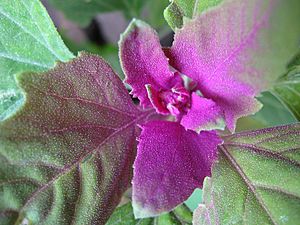Tree spinach facts for kids
Quick facts for kids Tree spinach |
|
|---|---|
 |
|
| Close-up of Chenopodium giganteum | |
| Scientific classification | |
| Genus: |
Chenopodium
|
| Species: |
giganteum
|
| Synonyms | |
|
|
Chenopodium giganteum, also known as tree spinach, is a tall plant that grows every year. It has many branches and can reach up to 3 meters (about 10 feet) in height. The main stem can be as thick as 5 centimeters (about 2 inches) at the bottom.
Contents
What Does Tree Spinach Look Like?
The younger leaves of tree spinach have a cool magenta (purplish-pink) color and are a bit fuzzy. As they get older, they turn green. The leaves are shaped like a diamond or an egg, and they can be quite large, up to 20 by 16 centimeters (about 8 by 6 inches).
The plant's flowers grow in clusters at the top, called an inflorescence. These clusters are shaped like panicles, which are branched groups of flowers. The flowers have both male and female parts (they are hermaphrodite). The wind helps to spread their pollen. Each flower has 5 outer leaves (called perianth leaves) and 5 pollen-producing parts (called stamens). Tree spinach starts to flower in August. Its tiny seeds are about 1.5 millimeters wide.
Where Does Tree Spinach Grow?
Tree spinach is related to other well-known plants like quinoa and Chenopodium album (lamb's quarters). Many plants in this group have been grown by people for a long time as food, either for their grains, leaves, or as animal feed. Because of this, it's sometimes hard to figure out exactly where they first came from. Tree spinach has two main types: one originally from India and another from America.
This plant grows well in places with a Mediterranean climate, which means warm, dry summers and mild, wet winters. However, it needs some shade, either full or partial. Tree spinach doesn't need very rich soil to grow. It also grows quickly and spreads easily, which are signs of a "weedy" plant. In some countries, like Germany and Slovakia, it's considered a new plant that has spread to areas where it didn't grow naturally. People don't usually grow tree spinach on large farms. But because it grows so well and produces a lot, it could become an important plant for food in the future!
How Can We Use Tree Spinach?
You can eat the young shoots and leaves of tree spinach. They are often cooked like regular spinach, which is also in the same plant family (the Amaranthaceae). Cooking helps to remove most of the oxalic acid and saponins, which are natural chemicals in the plant. Boiling the leaves for just 2 minutes at 100°C (212°F) is especially good for this. You can also eat the leaves raw in smaller amounts, for example, mixed into a salad.
The seeds of tree spinach can be cooked like rice or quinoa. You can also grind them into flour. This flour can then be mixed with other grain flours to make bread.
Because of its pretty pink-colored leaves, tree spinach is also grown just for its looks in gardens!
Is Tree Spinach Healthy?
Like many plants in the Amaranthaceae family, tree spinach contains some saponins and oxalic acid. If you eat too much of these chemicals raw, they can sometimes make you feel unwell. This is why it's a good idea to cook the leaves before eating them, especially if you plan to eat a lot.
See also
 In Spanish: Chaya para niños
In Spanish: Chaya para niños

